Abstract
Upon examination of Roman landscape paintings preserved in situ and in museums of Naples and Rome, additional evidence has been found for the additive character of creation of imaginary landscapes as well as evidence for using standardized elements and whole scene compositions in Roman painting. This attitude is compared to the modern way of creating virtual landscapes—computer game level design and the process called “kitbashing”. I propose that both these processes share the same task to create a familiar landscape using a visual language understandable to its contemporary viewer, but also a very similar method of using predefined elements.
1. Introduction
Digital reconstructions have become an essential tool not only for presenting results of archaeological research to the public, but also for verifying interpretative hypotheses during the research process itself [1]. It is a discipline where archaeology meets art in the form of computer graphics, and they work together to achieve goals that need to be defined in advance in order to balance the scientific and artistic approach [2]. When presented with a task to create a reconstruction of an excavated site, the scientific approach should prevail, the right technology must be chosen, the process must be documented, and criteria for measuring the certainty of the reconstruction must be defined and appropriately visualized in the resulting product [3,4]. On the other hand, when presented with a task to create a Roman set for a movie or a computer game, scientific trueness is usually not the main desired feature of the outcome and the production team has to focus more on the practical side of the result and on the audience. This freer approach makes it possible to rely more on predefined asset libraries and a method called “kitbashing”, which uses combinations of existing elements to create new scenes. Each time period or society has its own visual language full of allegories, allusions, and shortcuts. What was immediately understandable to Romans would be difficult to interpret for a modern person [5], making the final product incomprehensible and useless. It is, therefore, almost impossible for a modern artist to avoid using modern clichés about the ancient world entrenched in the audience by the past century of visual experience. As I believe that this is impossible to change by a scientific article, what is left is to attempt reconstruction of the working process of Roman painters and pinpoint the common areas where the work of modern artists meets with the work of their ancient counterparts and discuss whether this artistic process can be incorporated also to scientific reconstructions as defined in this paragraph.
As for the analyzed material, the vast majority comes from the Bay of Naples, less from Rome, and several mosaics useful for this study come from Sicily and North Africa. This paper mostly deals with paintings created between the first century BCE and first century CE, but occasionally will divert attention to much later mosaics dating from the second to the fifth centuries CE in order to show the development of the discipline. Analysis of the architecture, which is an indispensable part of the landscapes, has been done since the seminal works of Michael Rostovtzeff in the beginning of the 20th century. [6,7] Since then the corpus of known landscape paintings with architecture grew and so did the scholarship around it. Several large studies regarding the Roman landscape painting as a whole have been published [8,9,10], but scholars also started picking on the details. Apart from studies regarding the questions of the real-world models for the buildings and landscapes [6,11,12], there have also been studies dealing with singular elements that create the whole scene, such as the statues [13], villae [14,15], tower houses [16], naumachia [17], and sacred buildings [18,19,20]. Compilation of these studies allows us to decipher the visual language and comprehend the scenes that were most probably immediately clear to the ancient viewer. As I shall demonstrate in this article, this visual language used a lot of recurring elements, which may reveal more about the way this visual language spread and how the scenes were composed.
2. Additive Character of Roman Wall Painting
Construction of a scene using a set visual language can be called an additive process. However, it is additive in more ways than this. Not much is known about the reality of painters’ workshops in the first century CE, but the Edict of Diocletian on Maximum Prices differentiates two classes of painters, the pictor parietarius and the pictor imaginarius, the former being paid half of the latter. [21] Their tasks seem to have been divided, maybe not directly by skill, but certainly by what they were tasked to paint. The parietarii were responsible for the backgrounds and smaller decorations like the borders, leaving out space for the imaginarii who came in later and added the more complex and prominent scenes. It is also necessary to state that we do not know for sure whether or not at least a part of the painters for the muralists’ workshops were hired ad hoc, but it is certainly possible that the workshops were itinerant, at least within a rather small region, as we can, for example, recognize the style of the “Boscoreale workshop” in the Villa A of Torre Annunziata [22].
Roman landscape painting took various positions in the overall composition of the wall decoration from the second to the fourth Pompeiian style. Their size and position on the wall differed and while, especially in the second style, they occasionally created prospects “through the wall”, in the third style they mostly levitate in the middle of a single color panel, or they are shown as a tabula. The fourth style shows landscapes always as a theme of the tabula. [8] The latter tabulae are often placed between the second and third belt of decoration and were quite small, so it can be assumed that they were often merely a hardly visible space filler. Given the various positions and prominence given to landscapes in the overall decorative scheme, it is entirely possible that they were painted by both categories of painters as defined in the previous paragraph. While the quality of execution and prominence can vary, the visual language stays the same, as I shall demonstrate later.
The standardization of the motives and their spread across various media including wall painting, mosaics, and stuccos surely improved legibility of the scenes to the viewer. Roman landscape painting displayed untouched nature very rarely if ever. To my knowledge there is no landscape painting that would not show at least one sign of human action in the nature—it seems that it is always tamed at least by presence of an intelligent creature (a human, pygmy, or amor) and/or presence of a house, temple, altar, or a statue. One could say that nature becomes a landscape only after human interaction with it—its objectification, which leads to control over it [23,24,25,26]. Then for the landscape to become understandable to a broader audience, it needs to be created (in our case painted) by using a universal visual language, which means using repeating typical artefacts, buildings, and even whole scenes.
The result of this process was known to Romans as a topos and it is mentioned by Vitruvius (De Architectura VII.5.2, translation Morris Hicky Morgan):
“… ambulationibus vero propter spatia longitudinis varietatibus topiorum ornarent a certis locorum proprietatibus imagines exprimentes; pinguntur enim portus, promunturia, litora, flumina, fontes, euripi, fana, luci, montes, pecora, pastores.”
“… and their walks, on account of the great length, they decorated with a variety of landscapes, copying the characteristics of definite spots. In these paintings there are harbors, promontories, seashores, rivers, fountains, straits, fanes, groves, mountains, flocks, shepherds.”
It is interesting that he mostly speaks of the natural features with possible exception of harbors and shepherds. From the extant set of landscape paintings, it seems that the nature plays secondary role to the themes for topia, which are listed by Pliny the Elder (Naturalis Historiae 35.37, translation John Bostock):
“… non fraudanda et Studio divi Augusti aetate, qui primus instituit amoenissimam parietum picturam, villas et porticus ac topiaria opera, lucos, nemora, colles, piscinas, euripos, amnes, litora, qualia quis optaret, varias ibi obambulantium species aut navigantium terraque villas adeuntium asellis aut vehiculis, iam piscantes, aucupantes aut venantes aut etiam vindemiantes. Sunt in eius exemplaribus nobiles palustre accessu villae, succollatis sponsione mulieribus labantes, trepidis quae feruntur, plurimae praeterea tales argutiae facetissimi salis. Idem subdialibus maritimas urbes ingere instituit, blandissimo aspectu minimoque inpendio.”
“Studius too, who lived in the time of the late Emperor Augustus, must not be allowed to pass without some notice; for he was the first to introduce the fashion of covering the walls of our houses with most pleasing landscapes, representing villas, porticos, ornamental gardening, woods, groves, hills, fishponds, canals, rivers, sea-shores, and anything else one could desire; varied with figures of persons walking, sailing, or proceeding to their villas, on asses or in carriages. Then too, there are others to be seen fishing, fowling, or gathering in the vintage. In some of his decorations there are fine villas to be seen, and roads to them across the marshes, with women making bargains to be carried across on men’s shoulders, who move along slipping at every step and tottering beneath their load; with numberless other subjects of a similar nature, redolent of mirth and of the most amusing ingenuity. It was this artist, too, who first decorated our uncovered edifices with representations of maritime cities, a subject which produces a most pleasing effect, and at a very trifling expense.”
Here Pliny lists a wide range of both natural and man-made elements, which create the topia as we currently know them from archeological sources. “Despite obvious attempts to unify land and sea with devices like the birds eye view, ancient authors and artists regarded a place in the plural, as a sum of natural and man-made objects whose association forms one segment of the visual world.” [27] Only a sum of such places created from even smaller elements would create a landscape in the modern sense of the word, a choros for the Romans. This shows the additive approach, which the Romans had to real landscape as well as the virtual one, created on their walls.
3. Models and Copies—Results of the Survey
Examination of the paintings focusing on the modularity of the design proved fruitful and provided not only examples of direct copying but also of using images of certain buildings in various contexts and in the ultimate case of villa landscapes of creating very diverse imagery using only a few repeating key elements having the greatest visual impact.
The case for direct copying can be made for two paintings displayed in Museo Archeologico Nazionale di Napoli (MANN, inventory numbers prefix MN): MN 9474 found somewhere in Herculaneum (Figure 1) and MN 9458 found in the Villa of the Papyri (Figure 2). The former one is a wider panel showing a scene with three possibly sacred buildings placed on artificial podia, painted in perspective behind each other. The building in the front has stairs leading up to it from the side, an ornamental fence, and a garland. The three buildings fill the center of the panel and are backed by a symbolic rocky mountain. The right side of the panel is occupied by a tree behind the first building, a low fence-like structure, and possibly a statue of a fisherman. The left part is occupied by a scene that seems inspired by a standalone sacro-idyllic painting. A columnar monument is encircled by a crooked tree next to a hill slope. In front of the column there is a person carrying something on a stick resting on their shoulders. MN 9458 is a smaller panel, close to a square in format, and it shows almost exactly the same scene as the central and right part of MN 9474. John R. Clarke has already noticed similar “twins” in mythological scenes and this work owes a lot to his conclusions about the figural scenes being either directly copied and scaled or sometimes created by placing the predefined figures to different places [21]. The composition of MN 9458 is tighter. The scene is squished in order to fit it into the narrower space, but the central elements and the landscape in which they are set stay the same. In this case it is clear that the smaller panel is a slightly modified cutout of the larger one. Although both come from the area of Herculaneum, unfortunately we do not know the exact provenance of the larger panel, which is painted in a more refined style than the one from the Villa of the Papyri. I find it unlikely that they were painted by the same hand. However, it is certainly possible that they were created by two painters from the same workshop, who shared the same model-book. If we start analyzing some of the elements in further detail, we can notice more parallels to other paintings, otherwise unrelated. For example, the stone fence, sometimes used also as a bench upon which votives could be placed, appears in many other paintings in straight or curved form and is always connected with a depiction of a sacred space (a few of the other frescos containing this fence are, for example, in Naples MN 9401, 9403, 9414, 9419, 9439, 9475, 9399, 9508, and 9486, but also a mythological panel of Acis and Galatea MN 9244. A sacred landscape MN 147501 from the villa of Agrippa Postumus shows this element clearly as a high wall pierced by many windows. In Museo Nazionale Romano the motif appears many times on the landscapes from Villa Farnesina, mostly on the small architectural landscapes of the corridor F-G.).
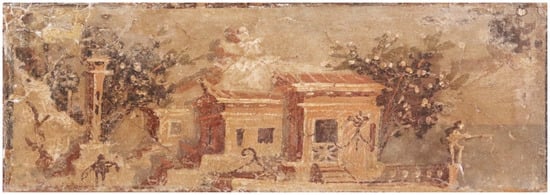
Figure 1.
Landscape fresco from Herculaneum (MN 9474).
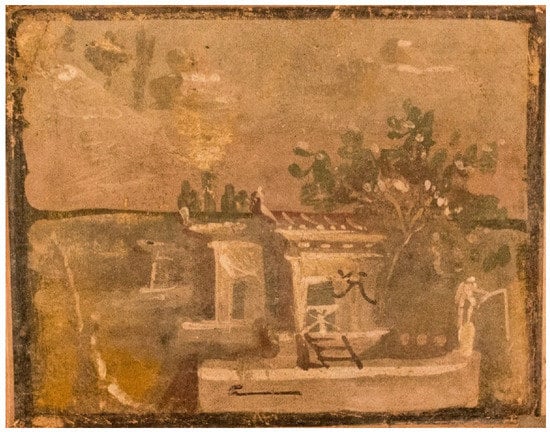
Figure 2.
Landscape fresco from the Villa of the Papyri (MN 9458).
A scene whose composition is closely related to the previous one can be used to show another way of transferring a scene—mirroring it. MN 9494 comes from an uncertain place in Pompeii (Figure 3), and MN 9497 from Villa Arianna in Stabiae (Figure 4). They share the long rectangular format and small dimensions. The main scene is composed of two (MN 9494) or three (MN 9497) aediculae in perspective behind each other along a body of water. The aedicula closest to the viewer is a low building with a slanted roof and large openings in the walls. The aediculae are surrounded by altars and statues. The background is occupied by a very schematic depiction of multistory villae represented by rows of arches in thin white lines. In this case, it is also possible that the painters came from one workshop and shared the same model-book, because, as I have mentioned above, the workshops could be itinerant and work outside their town of origin. Though we do not know from where this workshop came, the geographical distance between Pompeii and Stabiae makes it very possible for a Pompeiian workshop to work there. The decision to invert the scene might have originated in the desire to keep the whole decorative scheme of the wall symmetrical, but this is impossible to prove since we do not know the original context of these paintings in the overall scheme of their respective wall decorations.
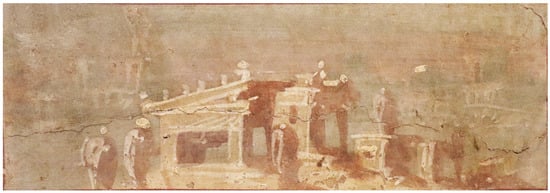
Figure 3.
Landscape fresco from Pompeii (MN 9494).
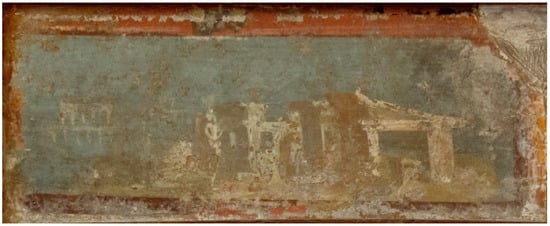
Figure 4.
Landscape fresco from Villa Arianna, Stabiae (MN 9497).
The third case can be demonstrated on paintings MN 9436 from Herculaneum (Figure 5) and MN 9503 from Pompeii, regio VI, insula occidentalis (Figure 6). Both show a pair of tower-like buildings in the same diagonal arrangements as the previous examples. The building closest to the viewer has a small porch, elevated protrusions in the top corners, and, in the case of MN 9503, some tall, narrow windows. It seems to be a variation of a tower house which can be defined as various buildings whose height is much larger than the other two dimensions. They can be found in different forms, which vary from an Egyptian reed house (MN 8561), an altar, tomb, or a sanctuary (Metropolitan Museum of Art, 20.192.1, but also Museo Nazionale Romano, 1233). The second building on the examined paintings varies much more between them. On MN 9503 the building is much taller, has windows in the upper part, and a covered porch. However, the roof type characteristic in this case, with a long, almost horizontal overhang, seems to be the same. In the background is yet another element that I have already described—the fence-like bench for offerings or a fence. As for staffage, MN 9436 shows only two very schematic human figures walking by the buildings. MN 9503 gives us a much livelier picture with several animals lying around, a seated person next to the first building, and a statuette possibly of a satyr. The differences between these two paintings are much bigger than between the previous sets. Not only were they not painted by the same hand, but I believe that the painters did not even see the same image from a common model-book. While it is possible that one painter saw the scene somewhere and then painted from memory, this also opens the possibility of transferring knowledge of common landscape compositions (maybe it is appropriate to call them topoi in this phase) orally as a mere description. Such intertwining between the visual and spoken language has been already studied in the frame of Roman painting and literature [28], but we can only hypothesize what was the relationship between language and the resulting visuals for painters in course of their work.
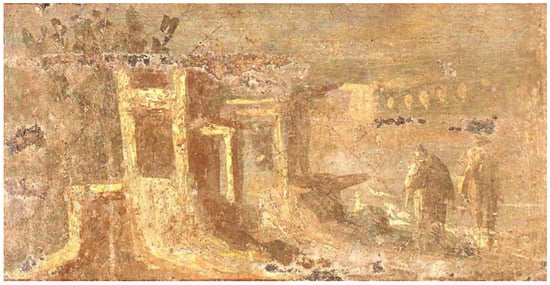
Figure 5.
Landscape fresco from Herculaneum (MN 9436).
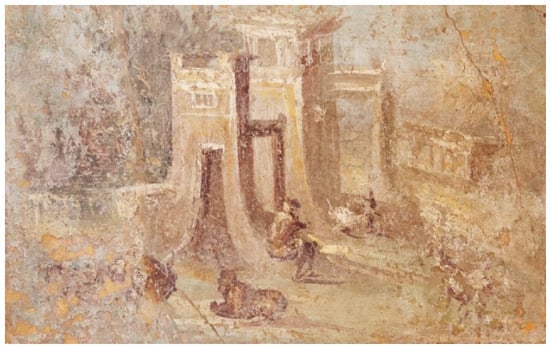
Figure 6.
Landscape fresco from Pompeii (VI, insula occidentalis) (MN 9503).
Three more frescos kept at the MANN (Figure 7) show a similar process as described above. The first of them is well known and exhibited: MN 9414 from Stabia. It is in a very good state of preservation. The painting style is focused on details and the play of light and shadow serves to highlight some features, not to hide them. The foreground shows a temple with a high staircase and characteristic roof, the pediment of which extends over the façade. The temple is partially covered by a crooked tree, in front of which is yet another example of the fence-like structure mentioned previously, now with three large and one small statues on top of it. This scene seems to be disconnected from the mid-plane by a body of water. Beyond it lies, presumably on an island or a peninsula, a long, single-story porticus running diagonally away from the temple in the foreground. At the end of the porticus is a complex building with a tower. The background is again separated by a body of water, possibly a river, and shows terrain with a hill and trees, the edge of which is covered by vaulted terraces with some small buildings on them. The top of the hill is crowned, possibly by a temple. The level of details diminishes as we move from the foreground to the background and atmospheric perspective is used to emphasize the depth of the scene.
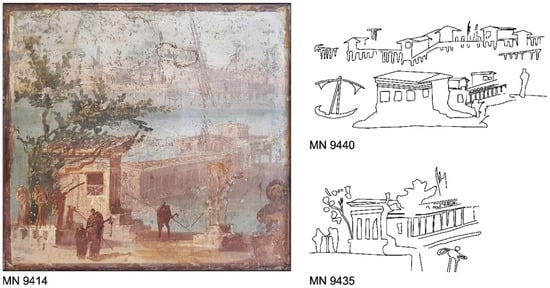
Figure 7.
Three landscape frescos with temple and porticus from Stabiae, Herculaneum, and Pompeii. The tracings are based on photographs from the MANN photographic archive.
This excellent piece of Roman art has two parallels at MANN, MN 9440 and MN 9435, which are not usually exhibited, and I can only present their tracings here. It is still clearly visible that their technical execution is far from their larger cousin described above, but a close look reveals that even the temple is of the same type with sides decorated by pilasters and the sides of the pronaos blocked by a pluteum. MN 9440 also shows more details of the landscape and of the background, which seems to be the same type with water and villae as in MN 9414, but its wider left part is dedicated to more water and a simple boat, rather than to the complicated scene with a tree and statues. MN 9435 is even more simplified and shows only the temple and the porticus along with some trees covering the background and figures in the front. This painting ends abruptly on the right side and, because it was cut from its original context including its original red frame, I believe that this is in fact a painter’s error caused by the process I described above. The pictor parietarius created the frame and left the space in it empty in order to be filled by pictor imaginarius. He had the idea or instruction which image should go in it, but scaled the scene wrong, resulting in cropping the scene in an imbalanced way. More on the issues of sketching and scaling in Roman painting can be found in [22].
So far, I have presented evidence for using model-books, displaying standardized building types and predefined scenes that might show a particular topos. However, I believe that the modularity and additivity of Roman architectural painting does not end there and can be traced beyond the complete buildings. This case is also closest to the modern practices that I will discuss in the last section of this paper. It is the case of villa depictions, which are mostly very schematic. They are but icons of real villae, representing the most important features for a viewer from the outside. As such, they are created mostly schematically by combining sections of portici, closed segments, and “towers” on a man-made podium next to a body of water. The variability of such approach is not great, so it is possible to recognize only a handful of types usually composed of 1–4 porticus elements [10], sometimes enlivened by presence of the closed segments depicting the second floor and with tower-like structures at the ends and in the corners. Some paintings show greater detail than others and seem more realistic by showing also other structures, which might as well create the actual livable core of the hypothetical villa. While the rest of this paper deals mostly with evidence from the pre-AD 79 Bay of Naples, I believe that the most coherent piece of evidence about virtual villa design in Roman art is the mosaic of the islands (Figure 8) found in the ancient city of Ammaedara in modern Tunisia, dated to the late third–early fourth century CE [29]. While it is a work of mythological chorography with only vague connections to real world, it also presents a unique set of all the types of villae that can be found in Pompeiian wall paintings of the first century BC–first century CE, which means that this iconographic tradition lasted for several hundred years and quite possibly across the artistic media. Another two examples of survival of this villa landscape tradition present itself at Villa Casale near Piazza Armerina, Sicily, where a semicircular atrium 36 is decorated by a mosaic of several villae composed of straight or curved portici and intermittent blocky or round buildings that frame a scene with fishing putti [30], while room 27 shows the same motif in smaller version with only one villa [30].
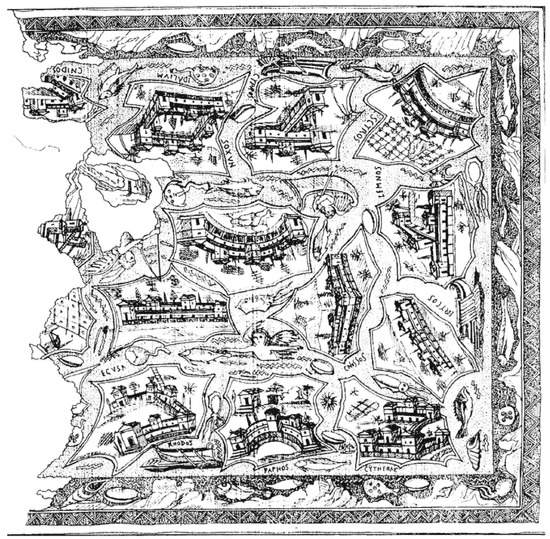
Figure 8.
Mosaic of the islands, Ammaedara. [After 29].
4. Conclusions
At the beginning of this article, I argued that the Roman wall painting was additive in character and that its landscape component showed a limited number of themes, topia, which were probably familiar to people of the period, and that they were constructed using a universally understandable visual language. In the next section, I provided new evidence for transfer of ideas not only by using model-books, which apparently did not serve only for figural scenes or decorative borders [31], but also the possibility of verbal transmission based on common knowledge among the painters. This last section will deal with connecting the Roman way of creating virtual landscapes and the modern way of creating them in the field of CGI and computer games.
The goal of modern level designers and the associated artists seems to be the same as the goal of their ancient counterparts—to create an immersive virtual scene that can be understood at least on a basic level by a wide audience with no deep knowledge of the underlying cultural framework. Modern computer games allow the audience not only to see the landscape, but also to actively participate in it. The virtual worlds are often vast and interactive, but they are built in a very similar way and using similar rules as the static landscapes the Romans painted on their walls. The primary purpose often remains the same—to fill a natural landscape with places, topoi, which are not completely alien to the viewers, where they can orient themselves using visual hints and the meaning of which they can deduce from visual clues. I propose that the most basic similarity between the ancient and the modern creation of landscape lies in the effective use of predefined models in order to create a new place, be it by copying known motifs from model-books or by kitbashing 3D models from an asset library. The reason behind this is to save time modeling and texturing each element used in the scene and also introducing only a limited number of new visuals that the users have to understand. The tradeoff lies in the limited possibility of modification. Nowadays, it is possible to purchase these kits based on the intended topic of the scene, for example, a set of generic Roman buildings (Figure 9) that can be used to create a scene with the appropriate feeling as easily as copying drawings from a model-book.
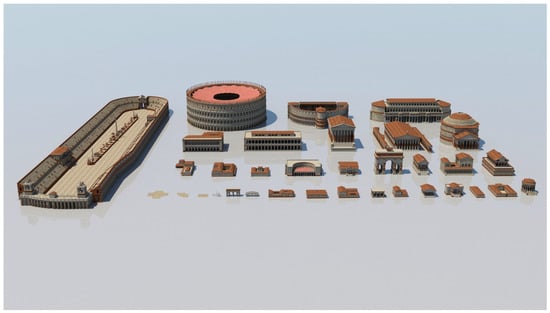
Figure 9.
Models contained in the Roman Empire asset kit by Kitbash3D.
The other effective option is to analyze the sketches of the desired results, identify the smallest reusable units, and create their models, meaningless on their own, which become meaningful only when combined to form something bigger, such as a house; but they can also be used to change and extend existing building models. In order to demonstrate this, I chose 3D assets used for making a computer game Assassin’s Creed: Odyssey, which takes place in Greece during the age of Pericles. This method allowed the artists to create very diverse and lively environments while using only a limited number of prefabricated models of both complete buildings and their individual parts (Figure 10). I would compare this approach to a painter’s sketchbook where they sketch particular details that might be reused in some later project. The whole composition of a temple area (Figure 11) once again does not correspond to anything we know from archeological record, but it is immediately clear what kind of place it shows, and the details added by composing the smaller assets into various outlying rooms and porches make the place look alive and possibly more relevant to its purpose in the game and the modern viewer than a reconstruction of a temenos filled with votive statues and offerings. In terms of creating such a scene, the statues and offerings would have to be significantly diverse, so they do not repeat in the scene. Such repetition would be distracting and make orientation in the space more difficult. From the artist’s point of view, it would mean creation of many more assets for the scene and this would probably be uneconomical and time consuming.
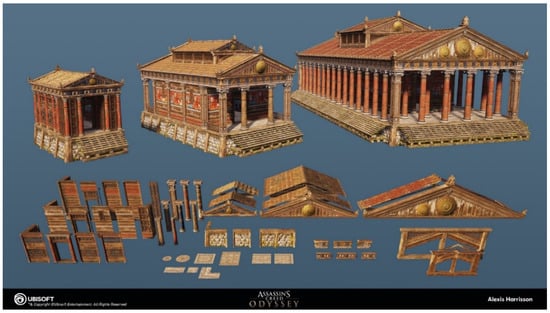
Figure 10.
Wooden Greek temple assets for Assassin’s Creed: Odyssey [32], TM and © Ubisoft Entertainment.
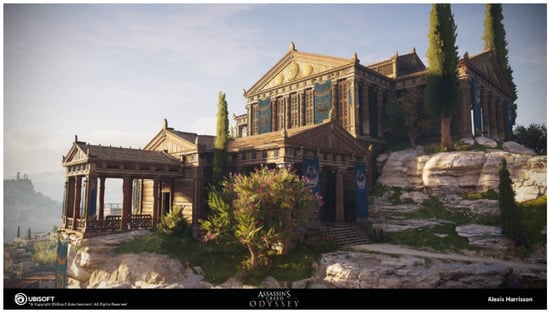
Figure 11.
Scene of Greek wooden sanctuary [32], TM and © Ubisoft Entertainment.
I have drawn parallels between the Roman way of creating painted landscapes, by combining elements found in a model-books or knowledge of motifs kept between the painters, and the modern way, where digital artists can also effectively use predefined models from an asset library in order to create something new. At first sight, it seems that this approach is purely artistic and unsuitable for evidence-based modeling, but at a closer look, we can find it even in the scientific reconstructions. Procedural modeling has been used for some time already and, while it is especially suited for creating virtual reconstructions of urban landscapes [33], it can be scaled both up and down, creating complex new scenes from smaller elements by using a defined set of rules. However, when it comes to complex and detailed archeological reconstruction of a site, the Extended Matrix [34] is a very promising formal language for management of sources and source-based modeling. I believe it has the ability to connect archeologists and artists and give them a strong tool to gather all possible evidence in a familiar form of a Harris Matrix and to create visually striking reconstructive hypotheses that can make use of predefined models on various scales.
Funding
This work was financially supported by Ministry of Culture of the Czech Republic (DKRVO 2019–2023/17.VI.a, National Museum, 00023272).
Institutional Review Board Statement
Not applicable.
Informed Consent Statement
Not applicable.
Data Availability Statement
Not applicable.
Acknowledgments
I would like to express my gratitude to Paolo Giulierini for kindly granting me access to the archives of MANN.
Conflicts of Interest
The author declares no conflict of interest. The funders had no role in the design of the study; in the collection, analyses, or interpretation of data; in the writing of the manuscript; or in the decision to publish the results.
References
- Demetrescu, E. Archaeological Stratigraphy as a formal language for virtual reconstruction. Theory and practice. J. Archaeol. Sci. 2015, 57, 42–55. [Google Scholar] [CrossRef]
- Demetrescu, E. Modellazione 3D, visualizzazione scientifica e realtà virtuale. In Archeologia Virtuale: La Metodologia Prima del Software: Atti del II Seminario, Palazzo Massimo alle Terme, Roma, 5–6 Aprile 2011; Gianolio, S., Ed.; Espera: Rome, Italy, 2012; pp. 149–155. ISBN 978-88-906443-1-3. [Google Scholar]
- London Charter. 2009. Available online: http://www.londoncharter.org/fileadmin/templates/main/docs/london_charter_2_1_en.pdf (accessed on 20 December 2020).
- Ename Charter. 2008. Available online: http://www.international.icomos.org/charters/interpretation_e.pdf (accessed on 20 December 2020).
- Trunk, M. Villa oder Heiligtum? Zur deutung zweier wandbilder aus pompeji. In Mousikos Aner: Festschrift für Max Wegner zum 90. Geburtstag; Brehm, O., Klie, S., Eds.; Antiquitas R. Habelt: Bonn, Germany, 1992; Volume 32. [Google Scholar]
- Rostovtzeff, M. Die hellenistisch-römische Architekturlandschaft. Römische Mitteilungen 1911, 26, 1–185. [Google Scholar]
- Rostovtzeff, M. Pompejanische Landschaften und römische Villen. Jahrbuch des Deutschen Archäologischen Instituts 1904, 19, 103–126. [Google Scholar]
- Peters, W. Landscape in Romano-Campanian mural painting; Van Gorcum: Assen, The Netherlands, 1963. [Google Scholar]
- Croisille, J.-M. Paysages Dans la Peinture Romaine: Aux Origines d’un Genre Pictural; Antiqua; Picard: Paris, France, 2010; ISBN 978-2-7084-0865-4. [Google Scholar]
- Hinterhöller-Klein, M. Varietates Topiorum: Perspektive und Raumerfassung in Landschafts- und Panoramabildern der Römischen Wandmalerei vom 1. Jh. v. Chr. bis zum Ende der Pompejanischen Stile; Phoibos Verlag: Vienna, Austria, 2015; ISBN 978-3-85161-116-8. [Google Scholar]
- D’Anneo, G. Architettura Romana Desunta dalle Pitture; Reale Accademia di Scienze, Lettere ed Arti: Palermo, Italy, 1940. [Google Scholar]
- Souček, J. What were they thinking? Villa Landscapes as a Source of Architectural Comparanda. In Picta Fragmenta. La Pittura Vesuviana—Una Rilettura; Giulierini, P., Coralini, A., Sampaolo, V., Eds.; Le Archeologie. Storie, Ricerche, Metodi; Silvana Editoriale: Milano, Italy, 2020; pp. 227–233. [Google Scholar]
- Moormann, E.M. La Pittura Parietale Romana Come Fonte di Conoscenza per la Scultura Antica; Van Gorcum: Nijmegen, The Netherlands, 1986. [Google Scholar]
- Thagaard Loft, G. Villa landscape in Pompeian Wall Painting—A Different Approach. Analecta Romana Instituti Danici 2003, 29, 7–27. [Google Scholar]
- Förtsch, R. Archäologischer Kommentar zu den Villenbriefen des Jüngeren Plinius; Philipp von Zabern: Mainz am Rhein, Germany, 1993. [Google Scholar]
- Grimal, P. Les maisons à tour hellénistiques et romaines. Mélanges l’école française Rome 1939, 56, 28–59. [Google Scholar] [CrossRef]
- Avilia, F.; Jacobelli, L. Le naumachie nelle pitture pompeiane. Rivista Studi Pompeiani 1989, 3, 131–154. [Google Scholar]
- Dall’Olio, L. Il motivo della ‘porta sacra’ nella pittura romana di paesaggio. Latomus 1989, 48, 513–531. [Google Scholar]
- Manzini, C. …duas antas…: Un motivo architettonico ricorrente nelle scene d’interno della pittura vesuviana. Orizzonti Rassegna Archeologia 2002, 3, 155–167. [Google Scholar]
- Fehrentz, V. Der “Baitylos” in der römischen Wandmalerei. Kölner Jahrbuch Vor Frühgeschichte 1991, 24, 85–90. [Google Scholar]
- Clarke, J.R. Model-book, Outline-book, Figure-book: New Observations on the creation of near-exact copies in Romano-campanian Painting. In Atti del X Congresso Internazionale dell’AIPMA, Association Internationale pour la Peinture Murale Antique, Napoli 17–21 Settembre 2007; Annali di Archeologia e Storia Antica; Quaderni/Dipartimento di Studi del Mondo Classico e del Mediterraneo Antico: Napoli, Italy, 2010; pp. 203–214. [Google Scholar]
- Clarke, J.R. Sketching and scaling in the second-style frescoes of Oplontis and Boscoreale. In La Villa Romaine de Boscoreale et ses Fresques. Actes du Colloque International Organisé du 21 au 23 avril 2010 aux Musées Royaux d’art et D’histoire de BRUXELLES et au Musée royal de MARIEMONT; Barbet, A., Verbanck-Piérard, A., Eds.; Éditions Errance: Paris, France, 2013; Volume II, pp. 199–209. [Google Scholar]
- Izzet, V. Form and Meaning in Etruscan Ritual Space. Camb. Archaeol. J. 2001, 11, 185–200. [Google Scholar] [CrossRef]
- Bryson, N. Vision and Painting: The Logic of the Gaze; Macmillan: London, UK, 1983. [Google Scholar]
- Berger, J. Ways of Seeing; Penguin: Harmondsworth, UK, 1973. [Google Scholar]
- Zarmakoupi, M. Between conceptual and perceptual space. The representation of Landscape in Roman Wall Paintings. In Peri-Graphikes. Pittori, Tecniche, Trattati, Contesti tra Testimonianze e Ricezione; Adornato, G., Falaschi, E., Poggio, A., Eds.; LED Edizioni: Milano, Italy, 2019; pp. 173–196. [Google Scholar]
- Bergmann, B. Meanwhile, back in Italy… Creating landscapes of allusion. In Pausanias. Travel and Memory in Roman Greece; Alcock, S., Cherry, J., Elsner, J., Eds.; Oxford University Press: Oxford, UK, 2001; pp. 154–166. [Google Scholar]
- Bergmann, B. Painted perspectives of a Villa Visit: Landscape as Status and Metaphor. In Roman Art in the Private Sphere. New Perspectives on the Architecture and Decor of the Domu, Villa, and Insula; Gazda, E.K., Ed.; The University of Michigan Press: Ann Arbor, MI, USA, 1991; pp. 49–70. [Google Scholar]
- Bejaoui, F. Îles et villes de la Méditerranée sur une mosaïque d’Ammaedara (Haïdra en Tunisie). C. R. Séances L’Académie Inscriptions Belles-Lettres 1997, 141, 825–858. [Google Scholar] [CrossRef]
- Pappalardo, U.; Ciardiello, R.; Pedicini, L.; Pedicini, M. Die Pracht römischer Mosaiken: Die Villa Romana del Casale bei Piazza Armerina auf Sizilien; Philipp von Zabern: Darmstadt, Germany, 2018; ISBN 978-3-8053-4880-5. [Google Scholar]
- Esposito, D. Disegno e creazione delle immagini nella pittura romana. In Atti del X Congresso internazionale dell’AIPMA, Association Internationale pour la Peinture Murale Antique, Napoli 17–21 Settembre 2007; Annali di Archeologia e Storia Antica; Quaderni/Dipartimento di studi del Mondo Classico e del Mediterraneo Antico: Napoli, Italy, 2010; pp. 215–226. [Google Scholar]
- Assassin’s Creed Odyssey—Wood Temples, Alexis Harrisson. Available online: https://www.artstation.com/artwork/LD8k0 (accessed on 24 November 2020).
- Haegler, S.; Müller, P.; Van Gool, L. Procedural Modeling for Digital Cultural Heritage. EURASIP J. Image Video Process. 2009, 2009, 1–11. [Google Scholar] [CrossRef]
- Demetrescu, E. Virtual Reconstruction as a scientific Tool: The extended matrix and source-based modelling approach. In Digital Research and Education in Architectural Heritage; Communications in Computer and Information Science; Münster, S., Friedrichs, K., Niebling, F., Seidel-Grzesińska, A., Eds.; Springer International Publishing: Cham, Switzerland, 2018; Volume 817, pp. 102–116. ISBN 978-3-319-76991-2. [Google Scholar]
Publisher’s Note: MDPI stays neutral with regard to jurisdictional claims in published maps and institutional affiliations. |
© 2020 by the author. Licensee MDPI, Basel, Switzerland. This article is an open access article distributed under the terms and conditions of the Creative Commons Attribution (CC BY) license (http://creativecommons.org/licenses/by/4.0/).